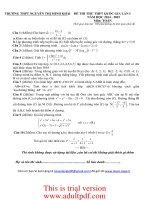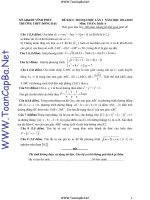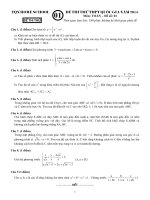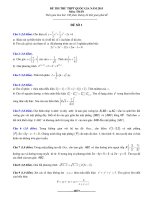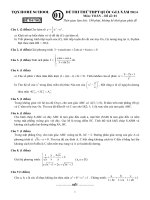Tải Đề luyện thi THPT Quốc gia môn tiếng Anh năm 2020 số 31 - Đề thi tốt nghiêp THPT 2020 môn Anh có đáp án
Bạn đang xem bản rút gọn của tài liệu. Xem và tải ngay bản đầy đủ của tài liệu tại đây (151.63 KB, 10 trang )
<span class='text_page_counter'>(1)</span><div class='page_container' data-page=1>
<b>ĐỀ THI THỬ THPTQG MÔN TIẾNG ANH</b>
<b>NĂM 2020 CÓ ĐÁP ÁN</b>
<b>Mark the letter A, B, C, or D on your answer sheet to indicate the word that differs from</b>
<b>the other three in the position of primary stress in each of the following questions.</b>
<b>Question 1. A. teacher</b> <b>B. lesson</b> <b>C. action</b> <b>D. police</b>
<b>Question 2. A. importance</b> <b>B. happiness</b> <b>C. employment</b> <b>D. relation</b>
<b>Mark the letter A, B, C, or D on your answer sheet to indicate the word whose underlined</b>
<b>part differs from the other three in pronunciation in each of the following questions.</b>
<b>Question 3. A. da te</b> <b>B. face</b> <b>C. page</b> <b>D. ma p</b>
<b>Question 4. A. played </b> <b>B. planned</b> <b>C. cooked</b> <b>D. lived</b>
<b>Mark the letter A, B, C, or D on your answer sheet to indicate the correct answer to</b>
<b>each of the following questions.</b>
<b>Question 5: Like most marine mammals and land mammals, whales are _______ creatures</b>
<b>A.blood-warmed B. warm-blood</b> <b>C. warm-blooded</b> <b>D. warm-blooding</b>
<b>Question 6: Fax transmission has now become a cheap and______ way to transmit texts and</b>
graphics over distance.
A. convenient <b>B. inconvenient</b> <b>C. uncomfortable</b> <b>D. comfortable</b>
<b>Question 7: She agreed that all the present paperwork _____ for everyone to have more</b>
time to socialize.
<b>A. stopping</b> <b>B. be stopped</b> <b>C. to stop</b> <b>D. stopped</b>
<b>Question 8: In today's paper, it _______ that there will be a new government soon.</b>
<b>A. writes</b> <b>B. tells</b> <b>C. states</b> <b>D. records</b>
<b>Question 9: The local press has been pouring _______ on the mayor for dissolving the</b>
council.
<b>A. scorn</b> <b>B. blame</b> <b>C. disapproval</b> <b>D. hatred</b>
</div>
<span class='text_page_counter'>(2)</span><div class='page_container' data-page=2>
<b>A. reduce</b> <b>B. produce</b> <b>C. increase</b> <b>D. preserve</b>
<b>Question 11: A curriculum that ignores ethnic tensions, racial antagonisms, cultural _____ and</b>
<b>religiousdifferences is not relevant.</b>
<b>A. contacts</b> <b>B. barriers</b> <b>C. diversity</b> <b>D. levels</b>
<b>Question 12: The speaker fails to get his message _______to his audience.</b>
<b>A. around</b> <b>B. in</b> <b>C. across</b> <b>D. out</b>
<b>Question 13: You are under no obligation ______ to accept this offer.</b>
<b>A. whatsoever</b> <b>B. eventually</b> <b>C. apart</b> <b>D. indeed</b>
<b>Question 14: There's a lot more to Willie than one would think: still waters run _______.</b>
<b>A. deep</b> <b>B. deeply</b> <b>C. deepness</b> <b>D. depth</b>
<b>Question 15: Many people and organizations have been making every possible effort in</b>
order to save _______ species.
<b>A. endangered</b> <b>B. dangerous</b> <b>C. fearful</b> <b>D. threatening</b>
<b>Question 16: Air pollution is getting _______ serious in big cities in the world.</b>
<b>A. more and more</b> <b>B. the more and the more</b>
<b>C. the most and the most</b> <b>D. most and most</b>
<b>Mark the letter A, B, C, or D on your answer sheet to indicate the word(s) CLOSEST in</b>
<b>meaning to the underlined word (s) in each of the following questions.</b>
<b>Question 17: The factory is fined for discharging dangerous chemicals into the river.</b>
<b>A. releasing</b> <b>B. increasing</b> <b>C. decreasing</b> <b>D. keeping</b>
<b>Question 18: A series of programs have been broadcast to raise public awareness of healthy</b>
living.
<b>A. experience</b> <b>B. understanding</b> <b>C. confidence</b> <b>D. assistance</b>
<b>Mark the letter A, B, C, or D on your answer sheet to indicate the word(s)</b>
<b>OPPOSITE in meaning to the underlined word(s) in each of the following questions.</b>
<b>Question 19: This speedy and secure service of transferring money can be useful.</b>
A. slow <b>B. rapid</b> <b>C. careful</b> <b>D.hurried </b>
</div>
<span class='text_page_counter'>(3)</span><div class='page_container' data-page=3>
<b>A. helpful</b> <b>B. friendly</b> <b>C. help</b> <b>D. polite</b>
<b>Mark the letter A, B, C, or D on your answer sheet to indicate the sentence that best</b>
<b>completes each of the following exchanges.</b>
<b>Question 21: -The shop assistant: “This is my last portable CD player. I'll let you have it</b>
for fifty dollars”.
-Stevenson: “ ?”.
<b>A. Could you give me your last CD?</b> <b>B. Can you tell me your favourite type of</b>
music?
<b>C. Could you give me a discount?</b> <b>D. Could you possibly give me fifty</b>
dollars?
<b>Question 22: -Customer: "Can I try this jumper on?".</b>
-Salesgirl: “ ?”.
<b>A. Yes, it costs one hundred and fifty dollars. B. No, the shop is closed in half an</b>
hour.
<b>C. Sorry, only cash is accepted here.</b> <b>D. Sure, the changing rooms are over</b>
<i><b>there. Read the following passage and mark the letter A, B, C, or D on your answer sheet to</b></i>
<i><b>indicate the correct word or phrase that best fits each of the numbered blanks from 23 to</b></i>
<i><b>27.</b></i>
<b>Nowadays people are more aware that wildlife all over the world is in (23)</b>
<b>. Many species of animals are threatened, and could easily become (24)__________</b>
if we do not make an effort to protect them. In some cases, animals are hunted for
their fur or for other valuable parts of their bodies. Some birds, such as parrots, are
<b>caught (25)________ and sold as pets. For many animals and birds the problem</b>
is that their habitat - the place where they live - is disappearing. More land is used for
farms, for houses or industry, and there are fewer open spaces than there once were.
Farmers use powerful chemicals to help them to grow better crops, but these chemicals
<b>pollute the environment and (26) _______ wildlife. The most successful animals on earth </b>
<b>-human beings - will soon be the only ones (27)______ unless we can solve this problem.</b>
<i>(Source: />
</div>
<span class='text_page_counter'>(4)</span><div class='page_container' data-page=4>
<b>Question 24: A. disappeared</b> <b>B. vanished</b> <b>C. extinct</b> <b>D. empty </b>
<b>Question 25: A. life</b> <b>B. alive</b> <b>C. lively</b> <b>D. live</b>
<b>Question 26: A. spoil</b> <b>B. wound</b> <b>C. wrong</b> <b>D. harm </b>
<b>Question 27: A. left</b> <b>B. alone</b> <b>C. staying</b> <b>D. survive</b>
<b>Read the following passage and mark the letter A, B, C, or D on your answer sheet to</b>
<b>indicate the correct answer to each of the questions from 28 to 35.</b>
The blue whale is the largest animal ever known to have existed. During the
20th century, the species was almost exterminated due to commercial whaling. The
species has slowly recovered following the global whaling ban but it remains
endangered and faces a number of serious threats including ship strikes and the
impact of climate change.
Blue whales are simply enormous with most ranging in length from 24-30 m.
The largest ever recorded was a gargantuan 33.5 m long. Females are up to 10 m longer
than males. And they can weigh up to 200 tonnes. Just to put that in perspective: an
adult male African elephant weighs 6 tonnes. The blue whale's heart is the size of a
small car and its beat can be detected two miles away. But that's nothing compared to
their calls. Blue whales are the loudest animals on earth and their calls are louder than a
jet engine: reaching 188 decibels, while a jet's engine hit 'just' 140 decibels. Apart from
their gigantic size, blue whales can be identified by their relatively small dorsal fin, a
fairly rounded rostrum (anterior part of the skull), and approximately 90 ventral grooves,
which reach the navel. They also have row of 300-400 baleen plates on each side of the
mouth, which are black in color and range in length from 50 cm in front to 100 cm in back.
Blue whales mostly travel alone or in groups of 2-3. Larger groups of up to 60
whales have been reported and are probably associated with feeding grounds. However,
the blue whale has the most powerful voice in the animal kingdom and its low-frequency
sounds can travel in deep water over hundreds, or even thousands, of miles. Under these
circumstances, animals which may appear to us to be traveling alone may actually be in
constant contact with one another.
</div>
<span class='text_page_counter'>(5)</span><div class='page_container' data-page=5>
once they have reached about 15 m in length, and are able to follow the normal migration
pattern alone. They reach sexual maturity at 5-10 years. This growth rate is astonishing and
is probably the fastest in the animal kingdom. From conception to weaning, it represents
a several billion-fold increase in tissue in just over a year and a half. Like other baleen
whales, the blue whale has no teeth so it is hard to tell its age but scientists believe they
live until at least 50.
Like other large whales, blue whales are threatened by chemical and sound
<b>pollution, habitat loss, overfishing of krill, ship strikes and becoming entangled in fishing</b>
gear. Climate change could also have a major impact on its food supply, since global
warming and associated ocean acidification may impact krill populations. In addition,
frontal zones - critical whale habitats - are projected to move further south due to climate
change. Frontal zones are boundaries between different water masses, where water can rise
from the depths, bringing with it large amounts of nutrients that stimulate the growth of
phytoplankton and support substantial populations of prey species for whales. Blue whales
would have to migrate further (perhaps 200-500 km more) to reach and feed at these
food-rich areas where they build up reserves to sustain themselves for the rest of the year. These
longer migration paths could increase the energy costs of migration and reduce the
duration of the main feeding season. As frontal zones move southward, they also move
closer together, reducing the overall area of foraging habitat available.
(Source: l <i>)</i>
<b>Question 28: What is the purpose of the author in the passage?</b>
<b>A.</b>To provide basic information about the blue whale and its major threats.
<b>B.</b>To prove that the blue whale is the biggest mammal on the Earth.
<b>C.</b>To give evidence of how the blue whale changes the habit and feeding grounds.
<b>D.</b>To raise people's awareness of the extinction of the blue whale,
<b>Question 29: Which of the following is NOT correct about the blue whale's physical</b>
description?
<b>A.</b>It is very easy to discover the appearance of a blue whale via its heart beat
<b>B.</b>Male blue whales are the longest in their species.
</div>
<span class='text_page_counter'>(6)</span><div class='page_container' data-page=6>
<b>Question 30: According to the passage, why isn't a blue whale lonely when it travels</b>
alone?
<b>A.</b>Because most of other blue whales also travel alone.
<b>B.</b>Because it can contact with others through their powerful voice.
<b>C.</b>Because it shares the same feeding grounds with others.
<b>D.</b>Because other blue whales will appear when it reaches the destination.
<b>Question 31: What does the word "wean" in paragraph 4 mean?</b>
<b>A. stop feeding a calf with its mother's milk</b> <b>B. stop growing as fast as before</b>
<b>C. begin living independently</b> <b>D. begin trying to find food</b>
<b>Question 32: The word "entangled" in paragraph 5 is closest in meaning to ______.</b>
<b>A. endangered</b> <b>B. disappeared</b> <b>C. ensnared</b> <b>D. attracted</b>
<b>Question 33: What does the word "it" in the last paragraph refer to?</b>
<b>A. the depth</b> <b>B. water</b> <b>C. water mass</b> <b>D. climate change</b>
<b>Question 34: According to the last paragraph, how does climate change affect the blue whale?</b>
<b>A.</b>It increases the acidity in the ocean, which makes the water polluted.
<b>B.</b>It impacts on the tide which contains a lot of nutrients to feed the blue whale's
prey.
<b>C.</b>It makes the blue whale travel farther south to find feeding grounds.
<b>D.</b>It encourages frontal zones so that the blue whale cannot move around.
<b>Question 35: It can be inferred from the passage that ______.</b>
<b>A.</b>Human activities are one of the primary reasons for the decline of the blue whale's
population.
<b>B.</b>The blue whale is the animal that has the longest life expectancy.
<b>C.</b>Despite being the largest animals, blue whales are the most vulnerable on the
Earth.
<b>D.</b>The blue whale lives safely in the ocean thanks to their solidarity.
<b>Read the following passage and mark the letter A, B, C, or D on your answer sheet to</b>
<b>indicate the correct answer to each of the questions from 36 to 42.</b>
</div>
<span class='text_page_counter'>(7)</span><div class='page_container' data-page=7>
<b>have found that most are incapable of growing quickly enough to compensate for rising</b>
sea levels triggered by global warming. The study suggests that reefs - which are already
suffering serious degradation because the world's seas are warming and becoming more
acidic - could also become overwhelmed by rising oceans.
<i>The research - led by scientists at Exeter University and published in Nature this</i>
week - involved studying growth rates for more than 200 tropical western Atlantic
and Indian Ocean reefs. It was found only 9% of these reefs had the ability to keep up
with even the most optimistic rates of sea-level rises forecast by the Intergovernmental
Panel on Climate Change. "For many reefs across the Caribbean and Indian Ocean
regions, where the study focused, rates of growth are slowing due to coral reef
degradation," said Professor Chris Perry, of Exeter University. “Meanwhile, rates of
sea-level rise are increasing - and our results suggest reefs will be unable to keep up.
As a result, water depths above most reefs will increase rapidly through this century.”
Sea levels rose by several inches over the past century and measurements
indicate the speed of this increase is now rising significantly. Two key factors are
involved: climate change is making ocean water warmer and so it expands. And as ice
sheets and glaciers melt, they increase amounts of water in the oceans.
At the same time, reefs are being weakened by ocean warming and also by
<b>ocean acidification, triggered as the seas absorb more and more carbon dioxide. These</b>
<b>effects lead to bleaching events that kill off vast stretches of coral and limits their</b>
ability to grow.
“Our predictions, even under the best case scenarios, suggest that by 2100, the
<b>inundation of reefs will expose coastal communities to significant threats of shoreline</b>
change,” said co-author Prof Peter Mumby of Queensland University. This point was
backed by US marine scientist Ilsa Ruffner writing in a separate comment piece for
<i>Nature. “The implications of the study are dire. Many island nations and territories are set</i>
to quickly lose crucial natural resources.”
<i>(Source: guardiamcomi)</i>
<b>Question 36: Which of the following does the passage mainly discuss?</b>
</div>
<span class='text_page_counter'>(8)</span><div class='page_container' data-page=8>
<b>C.</b>Coral reefs may escape from extinction because of the increase in sea levels.
<b>D.</b>Global warming will cause the rise of sea levels.
<b>Question 37: What does the word "compensate" in the first paragraph probably mean?</b>
A. recompense <b>B. keep up with</b> <b>C. develop</b> <b>D.benefit </b>
<b>Question 38: What did scientists at Exeter University find in their research?</b>
<b>A.</b>Tropical coral reefs are increasing more quickly than others in Pacific Ocean.
<b>B.</b>The majority of tropical coral reefs cannot keep pace with the increasing rate of
sea levels.
<b>C.</b>Many coral reefs are developing in spite of their degradation.
<b>D.</b>The rapid rise in sea levels does not affect the density of coral reefs.
<b>Question 39: According to the passage, the two factors causing the rise of sea levels are</b>
______.
<b>A. global warming and freeze</b> <b>B. severe weather and climate change</b>
<b>C. climate change and ice expansion</b> <b>D. climate change and ice melt</b>
<b>Question 40: What does the phrase "these effects" in paragraph 4 refer to?</b>
<b>A. ocean warming and ocean acidification</b> <b>B. reef weakening and ocean warming</b>
<b>C. reef weakening and ocean acidification</b> <b>D. ocean warming and CO2 absorb</b>
<b>Question 41: The word "inundation" is closest in meaning to _______.</b>
<b>A. drought</b> <b>B. extinction</b> <b>C. flood</b> <b>D. tsunami</b>
<b>Question 42: The author implies in the last paragraph that _______.</b>
<b>A.</b>even in the most optimistic prediction, coral reefs will experience their
extinction.
<b>B.</b>the results of the study are more serious than what scientists have predicted.
<b>C.</b>human activities will not only affect marine life but also put themselves at risk.
<b>D.</b>people often exploit natural resources in island nations and territories.
<b>Mark the letter A, B, C, or D on your answer sheet to indicate the underlined part that</b>
<b>needs correction in each of the following questions.</b>
<b>Question 43: Many people who live near the ocean depend </b> on it as a source of food ,
recreation, and to have economic opportunities.
</div>
<span class='text_page_counter'>(9)</span><div class='page_container' data-page=9>
economic
<b>Question 44: The number of wild horses on Assateague is increasing, resulted in</b>
overgrazed marsh and dune grasses.
<b>A. number</b> <b>B. is</b> <b>C. resulted</b> <b>D. grasses</b>
<b>Question 45: Many people object to </b> use physical punishment in dealing with discipline
problems at school.
<b>A. to use</b> <b>B. punishment</b> <b>C. dealing with</b> <b>D. at school</b>
<b>Mark the letter A, B, C, or D on your answer sheet to indicate the sentence that is</b>
<b>closest in meaning to each of the following questions.</b>
<b>Question 46:People say that at least ten applicants have been selected for the job interview.</b>
<b>A.</b>It is said that well over ten people are interested in having an interview for the
job.
<b>B.</b>It is said that no fewer than ten people are going to be interviewed for the job.
<b>C.</b>People say that fewer than ten job interviews have been held so far.
<b>D.</b>I have heard that only ten people have been chosen to have the job interviewed.
<b>Question 47: Eating with chopsticks feels strange to Jonathan.</b>
<b>A.</b>Eating with chopsticks isn't what Jonathan used to.
<b>B.</b>Jonathan is not used to eating with chopsticks.
<b>C.</b>Not feeling strange, Jonathan tries eating with chopsticks.
<b>D.</b>Jonathan didn't use to eat with chopsticks.
<b>Question 48: "Why don't you have your room repainted?" said Robert to Lan.</b>
<b>A.</b>Robert suggested having Lam's room repainted.
<b>B.</b>Robert asked Lam why you didn't have your room repainted.
<b>C.</b>Robert wanted to know why Lam doesn't have his room repainted,
<b>D.</b>Robert suggested that Lam should have his room repainted.
<b>Mark the letter A, B, C, or D on your answer sheet to indicate the sentence that best</b>
<b>combines each of sentences in the following questions.</b>
<b>Question 49: She received the exam results. She immediately phoned her morn.</b>
</div>
<span class='text_page_counter'>(10)</span><div class='page_container' data-page=10>
<b>B.</b>No sooner had she received the exam results than she phoned her mom.
<b>C.</b>No sooner had she phoned her mom than she received the exam results.
<b>D.</b>She received the exam results immediately after she phoned her mom.
<b>Question 50: She helped us a lot with our project. We couldn't continue without her.</b>
<b>A.</b>Unless we had her contribution, we could continue with the project.
<b>B.</b>But for her contribution, we could have continued with the project.
<b>C.</b>If she hadn't contributed positively, we couldn't have continued with the project.
<b>D.</b>Provided her contribution wouldn't come, we couldn't continue with the project.
<b>ĐÁP ÁN</b>
1 - D 2 - B 3 - D 4 - C 5 - C 6 - A 7 - B 8 - C 9 - A 10 - D
11 - C 12 - A 13 - A 14 - A 15 - A 16 - A 17 - A 18 - B 19 - A 20 - C
21 - C 22 - D 23 - C 24 - C 25 - B 26 - D 27 - A 28 - A 29 - B 30 - B
31 - A 32 - C 33 - B 34 - C 35 - A 36 - B 37 - A 38 - B 39 - D 40 - A
41 - C 42 - C 43 - D 44 - C 45 - A 46 - B 47 - B 48 - D 49 - B 50 - C
</div>
<!--links-->
<a href='l/'>: </a>

